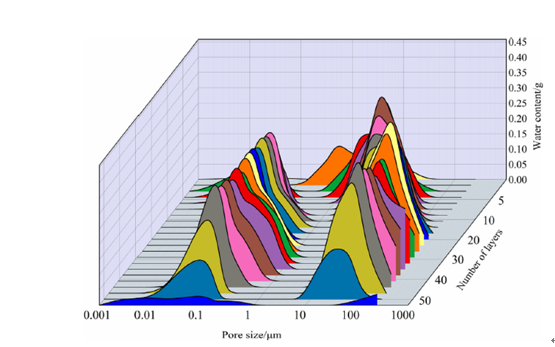RMN (Resonancia magnética nuclear) Es una técnica de medición física no destructiva que se utiliza ampliamente en diversos campos., incluyendo exploración petrolera y geológica, imágenes biomédicas, etc.. El principio básico de la RMN para medir la distribución del tamaño de los poros en núcleos de rocas se basa en el comportamiento de los núcleos de hidrógeno. (protones) en un campo magnético. Los núcleos de hidrógeno tienen propiedades magnéticas y pueden detectar y responder a un campo magnético aplicado..
-
Antecedentes teóricos:
Cuando los núcleos de hidrógeno se colocan en un campo magnético externo., Sufren precesión alrededor de la dirección del campo magnético.. La frecuencia de precesión es directamente proporcional a la fuerza del campo magnético aplicado.. Aplicando un pulso de radiofrecuencia., Los núcleos de hidrógeno pueden excitarse a un estado de mayor energía., con lo cual absorben energía. La frecuencia del pulso de radiofrecuencia determina la energía del estado excitado.. en rocas, El hidrógeno está presente principalmente en los poros como agua o materia orgánica.. Por lo tanto, Parámetros como la porosidad y la saturación de aceite se pueden calcular midiendo el tiempo de relajación y la susceptibilidad magnética de los núcleos de hidrógeno..
-
Medición de la distribución del tamaño de los poros:
La distribución del tamaño de los poros se mide en función del tiempo de relajación. (T2) de núcleos de hidrógeno. Cuando las moléculas de agua en los poros , interactúan con los núcleos de hidrógeno circundantes., lo que resulta en un cambio en su susceptibilidad magnética. La T2 aparente es inversamente proporcional al tamaño de los poros., entonces midiendo el T2, Se puede medir indirectamente la distribución del tamaño de los poros.. Generalmente, los poros pequeños corresponden a valores T2 más cortos, mientras que los poros más grandes tienen valores de T2 más largos. Al utilizar esta relación, La distribución del tamaño de los poros se puede determinar..
-
Aplicaciones:
Las técnicas de RMN tienen importantes aplicaciones en la exploración petrolera. Midiendo la porosidad y la distribución del tamaño de los poros de las rocas., Se puede evaluar la permeabilidad de los yacimientos y el potencial de explotación de los yacimientos petrolíferos.. Además, La RMN se puede utilizar para monitorear procesos como la inyección de agua y la inyección de gas para mejorar la recuperación de petróleo.. También se puede utilizar para comprender la distribución de fluidos y el comportamiento dinámico en yacimientos..
En resumen, La RMN no es destructiva., Técnica de medición no invasiva que se puede utilizar para medir la distribución del tamaño de los poros en núcleos de roca.. Al comprender la estructura de los poros y la distribución de fluidos en los yacimientos., es posible evaluar el potencial de explotación de yacimientos de hidrocarburos y formular estrategias de extracción efectivas. Las técnicas de RMN tienen importantes aplicaciones en el campo de la exploración geológica y petrolera, así como el desarrollo de recursos y la protección del medio ambiente..
 mohoso
mohoso
